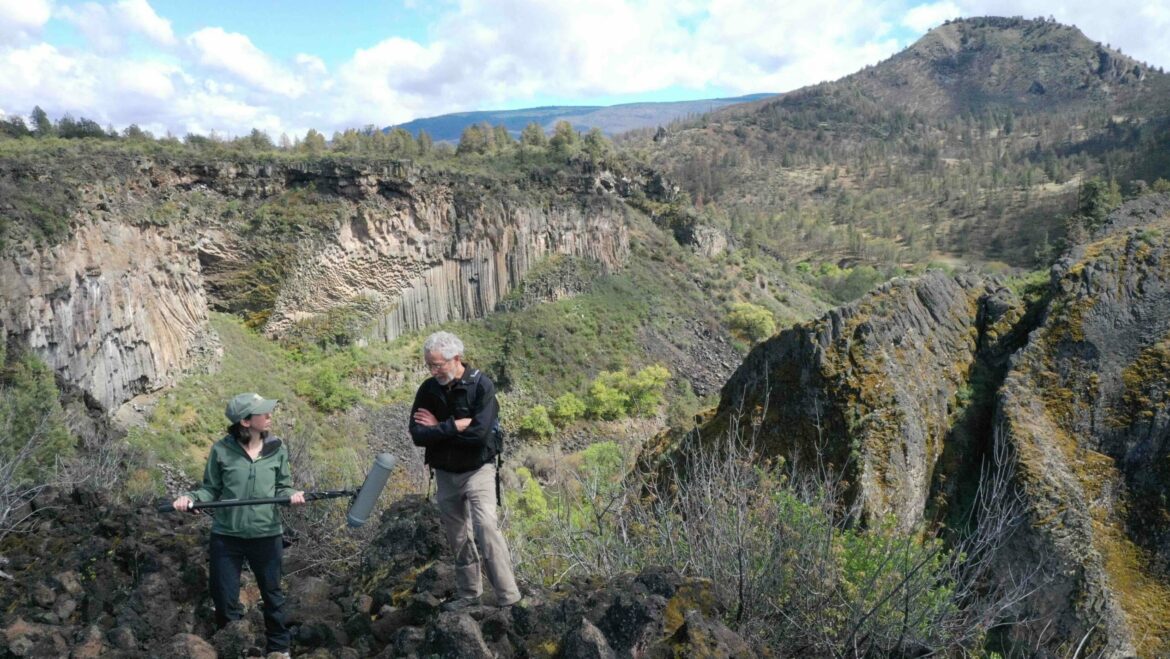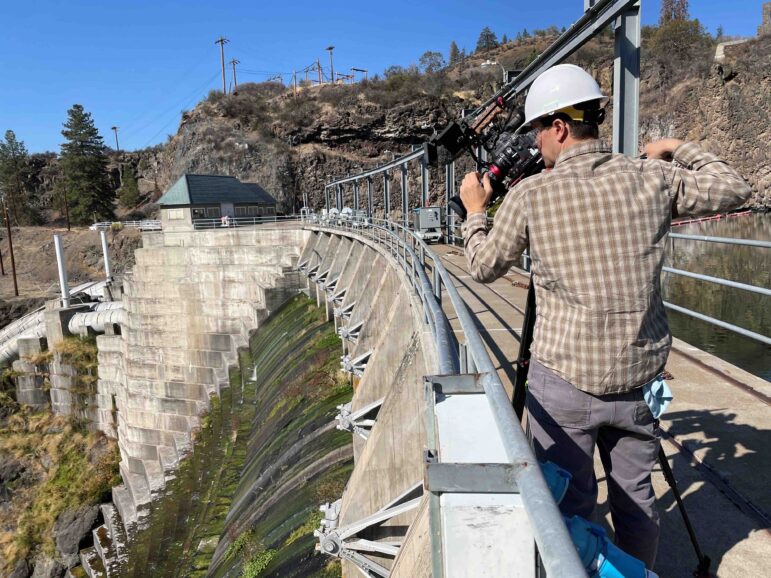Collaboration with newspapers repositions OPB in local news ecosystem

Brandon Swanson / OPB
OPB's Cassandra Profita interviews Bill Cross of American Whitewater for her multimedia coverage of the Klamath River dam removal project. The Grants Pass Daily Courier, a family-owned newspaper in southern Oregon, adapted Profita's report into a full-page spread for a Sunday edition.
A 10-year effort to strengthen collaborations between Oregon Public Broadcasting and dozens of local newspapers has resulted in a high degree of visibility and impact for OPB’s own journalism. It’s also helping our partner newspapers deliver valuable coverage to their readers.
The collaboration began as a way to ensure that OPB could access and give proper credit to local newspapers when we used their stories in radio newscasts. The content-sharing partnership also gave newspapers another resource for reporting news from outside their immediate coverage area, especially stories that had a broad impact on their readers. Over the years OPB’s reporting has become a significant source of news coverage published by many papers across the state and region.
One of the ways I measure the reach of OPB’s journalism is through LexisNexis. In 2022, I began receiving a steady stream of alerts for “OPB” and “Oregon Public Broadcasting” when our stories were republished by news organizations in Oregon and southwestern Washington. Through a recent analysis of OPB news coverage in the Nexis database, we learned that nearly 500 stories with bylines of OPB reporters appeared in Pacific Northwest newspapers in 2022. The vast majority of those news stories were published in Oregon newspapers. More than 25% appeared on the front pages of those newspapers.
The analysis revealed how Oregon’s newspapers are adapting to the challenges they face as their readership and advertising bases shrink, especially in urban areas outside of Portland.
The Salem Statesman-Journal serves Oregon’s state capital and its second-largest city by population (178,000). Owned by Gannett, the Statesman-Journal has been among the chain’s newspapers affected by several rounds of staffing cuts. Its website currently lists 12 reporters, including one columnist and one Report for America journalist. Last year, the Statesman-Journal republished more OPB stories than any other newspaper in Oregon. Of the 134 stories with OPB bylines, 51 of those appeared on the Statesman-Journal’s front page.
The Register-Guard serves Oregon’s third-largest city, Eugene (population 175,000). It became a Gannett property in 2019, when the chain merged with Gatehouse Media. As of February, it employed just five reporters. The Nexis analysis revealed that in 2022, the Register-Guard published 52 OPB-bylined stories on its front page.
According to the data, the top three categories of OPB stories picked up by local newspapers in 2022 were science/environment, politics and justice/policing. Those categories combined accounted for nearly three-quarters of OPB stories that were republished last year.
Helping information-challenged communities
OPB began laying the foundation for this publishing partnership in 2013. With a matching grant from the John S. and James L. Knight Foundation’s Community Information Challenge program, we worked with the Oregon Community Foundation to fund and build the Northwest News Partnership, a collaborative news network with newspapers from across the state. Within the first year, 17 newspapers had joined the partnership.
Participating news organizations used a digital platform to share news coverage. The platform was designed to connect directly to newspaper pagination systems, which made it easy for them to ingest stories into their publications.
By 2015, we recognized that the technology was less important than the relationships we’d formed through the partnership. We retired the content-sharing platform, moved to a simpler cut-and-paste model and continued working with the newspapers through the Northwest News Partnership.
Today, we have written agreements with 20 partners, including a commercial TV station in Medford, the newspaper serving the Confederated Tribes of the Grande Ronde, and the Lund Report, a digital publication focused on health-care news in Oregon. One partner owns a chain of small community newspapers in the Portland metro region and central Oregon. The partnership reaches every corner of the state from the coast to the high desert rural towns east of the Cascade mountains, from the Columbia River Gorge to communities on both sides of the Oregon-California border.
The agreements allow each newspaper to publish OPB stories in their print editions. Editors generally find stories they want to use on OPB’s website and simply copy and paste the text into their publishing systems.
Similarly, OPB editors monitor partner newspapers’ content every day and adapt some stories for broadcast. When a newspaper breaks news or is covering a high-profile story, for example, we’ll interview the lead reporter on our talk show. These types of stories air on OPB anywhere from five to 10 times per month.
The agreements require that we attribute republished coverage to the correct newspaper on air. Neither the newspapers nor OPB are allowed to post digital versions of each other’s stories.
Newsroom expansion
OPB has grown significantly as a news organization during the evolution of this partnership. In the early 2000s, the newsroom employed about a dozen journalists. Today, we employ 14 beat reporters, five beat editors, two breaking-news editors, a weekend editor and an investigative editor — all of whom work full-time under the leadership of Anna Griffin, VP of news, talk and podcasts.
The beat reporters include bureau staff in central Oregon and Vancouver, Wash., who provide on-the-ground coverage of those regions. Our daily journalism also is supported by teams that work on other productions or in other roles — staff for our talk show and podcast; on-air hosts; reporters, producers and editors in multimedia units that cover science and the environment and arts and culture; our visuals department; and the members of the digital content team. In total, OPB employs approximately 70 staff who are focused on journalism for multiple platforms. We now operate one of the largest newsrooms in the state.
Over the last five years, the majority of journalists joining our newsroom have come from newspapers. As they brought their experiences with print- and text-based digital journalism, it meant that OPB’s news stories are now more easily adapted for print publication. A couple of our new hires came to us from Northwest News Partnership publications. Under the content-sharing agreement, their work continues to be published by their previous employers.
Multimedia reporting by Cassandra Profita, one of our science and environment reporters, provides a good example of how OPB’s coverage can be adapted for high-impact print journalism. A package she reported last fall, “The world’s largest dam removal will touch many lives in the Klamath River Basin,” included an in-depth text story, photos and a short video on a deconstruction project approved by the Federal Energy Regulatory Commission. The project, set to begin this year, will open up nearly 400 miles of river habitat in southern Oregon and northern California, including waters traditionally fished by the Karuk, Yurok and other tribes.

The Grants Pass Daily Courier, a family-owned newspaper in southern Oregon, republished Cassandra’s stories and photos as a full-page spread in a Sunday edition. The Daily Courier has a small staff and would have struggled to cover this story itself. It benefited from being able to repackage the coverage for print. OPB got a byline and attribution credit in a newspaper whose readers are mostly unfamiliar with us. OPB’s broadcast coverage area does not include that part of the state.
Fragile economics of local publishers
Early this year, one of our partners, the Medford Mail-Tribune, shut down entirely with just a few days notice. A new owner had attempted to build a robust digital news service in conjunction with the print publication but couldn’t make the business model work.
The Medford Mail-Tribune’s struggle to stay in business is typical of the challenges faced by newspapers in Oregon communities beyond the metropolitan Portland media market. These newspapers serve tightly-knit, smaller cities and towns, each with a base of locally-owned businesses. But declining readership of print newspapers and the rising costs of printing and distribution have made it difficult for them to remain profitable.
In the wake of the Mail-Tribune’s demise, two locally-owned publishers moved quickly to increase their service to the Medford area. One of them is the owner of the Grants Pass Daily Courier. Both publishers now looking to serve Medford are already part of our collaborative network. We expect to continue supplying stories for new and existing print publications in that region.
As several local newspapers struggled to keep their doors open in the last few years, OPB hasn’t seriously considered an acquisition or merger. In large part, that is due to the willingness of other local publishers to step in. For example, when the Bend Bulletin faced financial trouble, a family-owned newspaper publishing company, EO Media, ultimately bought the paper. EO Media newspapers in Astoria and Pendleton were among the original members of the Northwest News Partnership. When the Bend Bulletin joined EO Media’s portfolio of newspapers, it also became a partner.
Journalistic ambitions
One of the biggest questions we face now is how to build upon the data we’ve collected about newspapers’ use of OPB stories. We see an opportunity to continue raising OPB’s visibility among newspaper readers throughout the Pacific Northwest. Some of them may be fans of public media already, while others may not be aware of what public media offers today.
We plan to explore whether any of our partner newspapers would be willing to trade ad space in return for the stories we supply. This would open up relatively easy opportunities to promote OPB radio and television programming while raising the profile of our brand. If done correctly, we could also highlight our membership model outside the context of an individual story. We have also created a framework for collaborative reporting and publishing with partner newspapers around topics of significant interest. So far, we’ve collaborated successfully on election coverage and reporting on the impact of suicide deaths in local communities.

OPB is marking its 100th anniversary this year. While we celebrate that achievement, our primary focus is looking to the future and improving our public service journalism for the next century.
OPB’s new strategic framework, adopted in 2021, emphasizes growing the reach and impact of our journalism, knowing and growing engaged and supportive digital audiences and creating an internal structure and culture that will help us evolve to improve our community service and better reflect the growing diversity of audiences in our region.
OPB made its mark serving small farming towns at the beginning of its first century. As we embark on the second, our ambitions are greater and our hope is to match that ambition with the impact on the communities we serve.
As OPB’s CCO, Morgan Holm oversees local content production on broadcast and digital platforms. Since joining OPB in 1990, he has worked as reporter, assignment editor, producer, host and news director.






